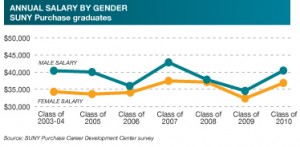More jobs for 2010 grads

“Help wanted” is not an archaic phrase in the real world off the college campus, it seems.
Graduates in the Class of 2010 at Purchase College have fared slightly better in the job market than graduates of the previous class, according to a survey by the SUNY school”™s career development center. And School of Arts graduates, dispelling the starving-artist stereotype, fared best of all among Purchase alumni in their class.
Of 449 graduates responding to the seventh annual survey, 90 percent said they were either employed, in graduate school or juggling a job and school. That is a 2.6 percent increase from the 2009 survey of graduates, career development officials said.
Graduates reporting they had found full-time or part-time work represented a 4 percent increase from the class of 2009. Graduates landing full-time work represented a 5.2 percent increase from the previous year.
“This seems to be a national trend,” said Wendy Morosoff, director of the Purchase College career development center. “Everybody”™s numbers are slightly up for employment and still slightly up for graduate school, too.”
For the class of 2011, “I would guess that things are going to continue to improve slightly,” Morosoff said.
The career center director saw a sign of a more active job market in the number of employers, 60, which already have registered for the college”™s annual job and internship fair in March. That is well ahead of registrations last year, when 75 employers participated, short of the center”™s goal of 100 employers. That goal should be easily reached this year, Morosoff said.
The share of 2010 alumni who were unemployed was down 1.1 percent. Of those in the jobless ranks, 45.8 percent were enrolled in graduate or professional programs, a 3.2 percent increase; 3.6 percent listed themselves as homemakers or caregivers, a 1 percent increase, and 10.8 percent were unpaid interns, apprentices or volunteers, up 2.5 percent.
School of Arts graduates led their classmates in finding work, with 89 percent reporting full-time or part-time work. That was a 7 percent increase from the Class of 2009.
Arts graduates also led their classmates in reporting a relationship between their academic major and current job positions.
The share of respondents reporting that their employment was not related to their field of academic study, 39.4 percent, represented a 4.3 percent decrease from 2009. Career center officials said that may be another sign that students can be slightly more selective in their job search.
The mean or midpoint salary for 2010 graduates employed full-time was $38,426, a 12 percent increase from 2009.
The salary gap between males and females continued in 2010, with men reporting an average salary of $37,503, compared with $35,238 for women. The mean full-time salary for male respondents was $40,556, compared with $36,939 for females, an 8-percent difference.
“Interesting for us, last year there was more of a disparity than the year before,” said Morosoff. “A lot has to do with the jobs that they”™re finding,” with women often taking teaching and social services jobs or working at lower-paying nonprofit agencies.
Still, “There”™s discrimination, there”™s no question about it.”
The career development center in the past year offered a program for women on salary negotiations, Morosoff said. This year the college will sponsor a salary-negotiations workshop for women presented by the Women”™s Bureau of the state Department of Labor.